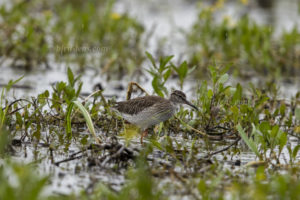 In the 18th century settlers made the long, marshy lowland area of the Warta and the river Netze habitable. Individual farmsteads and villages from that time can still be seen from the dike of the Warta. None of the houses has no stork nest.
In the 18th century settlers made the long, marshy lowland area of the Warta and the river Netze habitable. Individual farmsteads and villages from that time can still be seen from the dike of the Warta. None of the houses has no stork nest.
Today, only the diked areas at the Warta estuary reminds of the original landscape. The meadows between Kostrzyn and Slonsk are gradually being drained here via an old trench and canal system.
Today only a few farmers graze their cattle and horses here. Therefore, herbaceous thickets and willow bushes are increasingly spreading to many areas that have long been no longer cultivated in today’s national park. The easiest way to get to the national park is from Kostrzyn via the main road 133 to Slonsk, a larger village that used to have city rights in former times. After entering the village turn left at a grocery store to take the road to Przyborow. In this village, a paved road leads to the right of the paved road to a concrete country road, which ends for cars at a bridge with a sheltered hut. Behind it, the concrete runway meanders over three kilometers along the Postomia to the Warta. Another easy-to-access gateway starts at Przyborow, on the right off the main road, just opposite a simple shop. The bumpy side path leads down to the causeway along the canal, where Great Grebes (Podiceps cristatus) are often seen. Sometimes Red-necked Grebes (Podiceps grisegena) or Grey Herons (Ardea cinerea) can be found there, and seagulls (Larus spec.) and Cormorants (Phalacrocorax carbo) almost always hunt across the water. At sunrise there is often fog over the water and the meadows, and there is a perfect silence that is interrupted only by the cries of single gulls.
The lowlands with their waters and bush groups are best viewed from observation towers or from the high dam that begins behind Slonsk. This artificial wall of protection limits the floodplains for miles and ends at quite close to the Warta several kilometers further east. Access to the meadows outside the national park also leads from the dam. During breeding season, caution should be exercised even here on the paths. Once I almost tripped over the nest of a Little Ringed Plover (Charadrius dubius). The area is charming in every season. The birds, the bizarre trees along the paths and in the meadows, the aquatic plants as well as the flowering wetlands, which are all dressed in yellow in spring, offer a wealth of different photo opportunities.
In order to meet the growing demand for top images of the rarer species of Palearctic Bird-lens.com has specifically made trips to remote places like the coastal mountains of western Norway, in the winter to a secluded harbor in Denmark, or – right now – to the dunes of The Netherlands. This to do everything to ensure excellent photos of the Birds of the Western Palearctic. The yield of pictures also of rare Western Palearctic birds is very good. The beautiful picture that you see in blog is just a first impression of what you will find behind the tab “Picture Shop” very soon. Just give a notice if you need a picture of a bird before the new images are online